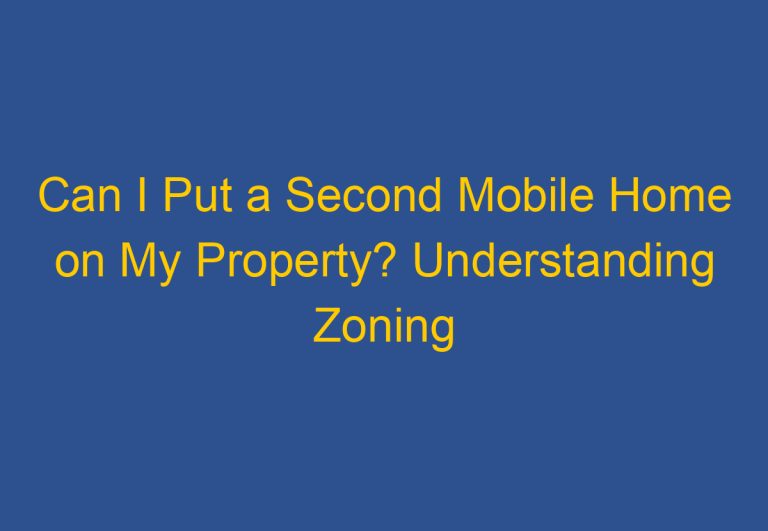How Many Mobile Homes Can I Put on My Land: A Comprehensive Guide
When it comes to owning land, one of the questions that may arise is how many mobile homes can be placed on it. The answer to this question varies depending on a number of factors, including the size of the land, local zoning regulations, density restrictions, and infrastructure requirements. However, there are some general guidelines that can help individuals determine the number of mobile homes that can be placed on their land.
According to zoning regulations, a minimum lot size of 10,000 square feet per mobile home is required, and there is a maximum density of 10 homes per acre. This means that if you have a one-acre property, you can potentially accommodate up to 10 mobile homes. However, it is important to note that setbacks, access roads, and utility connections should also be taken into consideration when determining the number of mobile homes that can be placed on a property.
To get a more accurate estimate of how many mobile homes can be placed on a specific piece of land, it is recommended to consult with the appropriate regulatory agency in your state or community. This may be the Department of Economic and Community Development Local Planning Assistance Office or a similar agency. By following the specific laws and regulations in your area, you can determine the allowable number of mobile homes that can be placed on your land.
Understanding Zoning and Land Use Regulations
When it comes to placing mobile homes on a piece of land, there are various zoning and land use regulations that must be followed. These regulations can differ depending on the location and the type of land. It is vital to understand these regulations to determine the number of mobile homes that can be placed on the land.
Zoning Ordinances and Mobile Homes
Zoning ordinances are a set of regulations that govern the use of land in a specific area. These ordinances are created by local governments and are designed to ensure that land is used in the best interest of the community. When it comes to mobile homes, zoning ordinances typically specify the minimum lot size, maximum density, and setbacks required for each unit.
Local Regulations and Compliance
Local regulations are laws that govern the use of land in a specific city or county jurisdiction. Compliance with these regulations is essential to avoid penalties and fines. In many cases, local regulations will incorporate the zoning ordinances mentioned above. Compliance with these regulations can be enforced by the zoning administrator, who is responsible for ensuring that all land use is in compliance with the regulations.
Permits and Inspections
Before placing a mobile home on a piece of land, a building permit must be obtained. This permit ensures that the mobile home is constructed in compliance with national manufactured housing construction and safety standards and building codes. Inspections are also conducted to ensure that the mobile home is safe and habitable.
Overall, it is essential to understand the zoning and land use regulations in the area where the mobile home will be placed. Compliance with these regulations is necessary to avoid penalties and fines. To ensure compliance, it is recommended to consult with the planning department or zoning administrator in the area.
Site Preparation and Installation
Land and Infrastructure Requirements
Before installing a mobile home on a piece of land, one must first ensure that the land meets the necessary requirements. The size and shape of the lot will depend on the size of the mobile home being installed. A single-wide mobile home typically requires a lot size of at least 0.5 acres, while a double-wide mobile home may require a lot size of 1 acre or more. It is important to check the local zoning laws and regulations to ensure that the chosen property is zoned for mobile homes.
The soil test is another important consideration. A soil test will determine whether the soil is suitable for a mobile home foundation and can support the weight of the home. It will also determine whether the land is in a flood zone and if any special measures need to be taken to ensure proper drainage.
Setting Up Utilities and Connections
Setting up utilities and connections is another important step in preparing a site for a mobile home. Electricity, water, and sewage connections must be installed and connected to the mobile home. In some cases, a septic tank may need to be installed.
It is important to hire a licensed contractor to install the utilities and connections. The contractor should be familiar with the installation standards and requirements for mobile homes.
Mobile Home Placement and Foundation
Mobile home placement and foundation is the final step in preparing a site for a mobile home. The mobile home must be placed on a solid foundation that is level and properly anchored to the ground. The foundation should be built to meet the installation standards and requirements for mobile homes.
The placement of the mobile home should also take into consideration the property lines, garage, driveway, and drainage. It is important to have a survey done to ensure that the mobile home is placed within the property lines and that the garage and driveway are properly situated.
In conclusion, site preparation and installation are crucial steps in installing a mobile home on a piece of land. By following the necessary requirements and hiring a licensed contractor, one can ensure that the mobile home is installed properly and meets all necessary standards and regulations.
Frequently Asked Questions
What are the zoning requirements for placing multiple mobile homes on a single parcel of land?
The zoning requirements for placing multiple mobile homes on a single parcel of land vary depending on the location. It is important to check with the local zoning authority to determine the specific requirements for your area. In general, the zoning requirements may include minimum lot size, maximum density, setbacks, and access to utilities.
What permits are needed to install a mobile home on private property?
To install a mobile home on private property, several permits may be required. These may include a building permit, electrical permit, plumbing permit, and mechanical permit. It is important to check with the local building department to determine the specific permits required for your area.
How does property tax apply to mobile home owners in California?
In California, mobile homes are classified as personal property and are subject to personal property taxes. However, if the mobile home is permanently affixed to a foundation and the owner owns both the land and the mobile home, it may be eligible for a conversion to real property. This would result in the mobile home being taxed as real property.
Are there specific building codes that regulate the installation of mobile homes?
Yes, there are specific building codes that regulate the installation of mobile homes. These codes may vary depending on the location. In California, mobile homes are regulated by the Department of Housing and Community Development (HCD) and must comply with the California Mobilehome Parks Act and the Mobilehome Parks Regulations.
What is the maximum number of mobile homes allowed on a residential lot?
The maximum number of mobile homes allowed on a residential lot varies depending on the location and the zoning requirements. In general, the zoning regulations require a minimum lot size of 10,000 square feet per mobile home and a maximum density of 10 homes per acre.
Is a mobile home classified as real property or personal property in California?
In California, mobile homes are classified as personal property unless they are permanently affixed to a foundation and the owner owns both the land and the mobile home. If the mobile home meets these requirements, it may be eligible for a conversion to real property.










